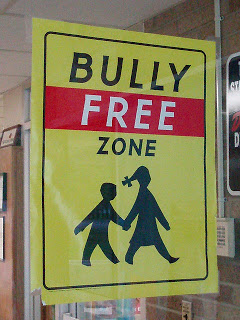When R was three weeks shy of four years old, he moved into the preschool room at his (now former) daycare. The class was a mix of ages up to five, and R was the youngest by a few days. We were all excited about the new class, including R. Unfortunately, a short time in the class uncovered problems, the most striking was when two older boys started calling R “stupid baby” on a regular basis.
We drill into our kids that stupid is a bad word, and that using words like that are just as hurtful as hitting someone, so R knew what those boys were saying was wrong. It made him sad. Thankfully, he told me what was happening, and we strategized how to respond (Say no thank you and go play with someone else, for example). But, since he was so small, I also talked with his teachers. After three conversations (that’s another blog post altogether), the teachers addressed the name calling with the older boys, and it eventually stopped. And, by the end of the year, R was happy to play with those boys, with “stupid baby” a distant memory.
I, on the other hand, was never able to forgive those boys for picking on my child. I never followed up when the mother of one of them, oblivious to her son’s behavior, suggested a playdate. I monitored every story R told me about them, more closely than stories about other children, and was relieved when we changed day cares and R forgot about them.
We’re fortunate that our first experience with bullying was brought to our attention so quickly and addressed successfully. But it left me disheartened. How did these children know how to pick on my son? On any kid? How do our children learn bullying?
So with these questions in mind, I attended a lecture on bullying the other night, sponsored by the parenting network in my town. The speaker was a child psychologist and early education specialist named Dr. Donna Housman. During her talk, which was titled “Understanding Bullying and Emotional Intelligence,” Dr. Housman shared startling statistics about bullying, including the fact that 13 million children in the US will be bullied this year with one out of every four children bullied at some point in their childhood. Dr. Housman emphasized that in order to respond to bullying we must raise children who have “an enhanced self-awareness of one’s emotions, ability to manage and deal with the intensity of one’s emotions, and sensitivity to the emotions of others.” These qualities, which define emotional intelligence, create people who are more aware of themselves and others, are more empathic, and are less likely to bully or be isolated from others, a key attribute of victims of bullying.
Dr. Housman also explained that 80% of children who witness bullying do nothing to stop it–a problem that persists into adulthood and creates significant problems for our society. She therefore introduced the idea of raising children who are “upstanders.” As you might have guessed, an upstander is the opposite of a bystander; it is someone who will help a person in trouble or in a need. Teaching our children how and when to intercede is important, as the response is specific to the situation and the child’s age. For example, an upstander could be a friend to the victim of bullying, ensuring the person in trouble knows that she or he is not alone. Or, an upstander could get an adult if a child’s safety is in question.
What I took away most of all from Dr. Housman’s presentation, though, was how critical it is for my children (all children, in fact) to have someone they trust (such as a parent or teacher) to talk to when times are bad–and good. Keeping the lines of communication open is a must, and something I work at each day with my kids.
I didn’t leave the talk with a solution to end bullying, but I did leave more determined than ever to make sure my children know how much they are loved and that I am here for them no matter and to ensure the values of compassion and empathy are emphasized in our home.
If you have successful anti-bullying tips, please share in the comments below. Together, I hope, we can make a difference.

